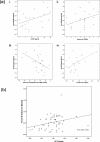Circulating endotoxemia: a novel factor in systemic inflammation and cardiovascular disease in chronic kidney disease
- PMID: 20876680
- PMCID: PMC3022234
- DOI: 10.2215/CJN.04610510
Circulating endotoxemia: a novel factor in systemic inflammation and cardiovascular disease in chronic kidney disease
Abstract
Background and objectives: Translocated endotoxin derived from intestinal bacteria has a wide range of adverse effects on cardiovascular (CV) structure and function, driving systemic inflammation, atherosclerosis and oxidative stress. This study's aim was to investigate endotoxemia across the spectrum of chronic kidney disease (CKD).
Design, setting, participants, & measurements: Circulating endotoxin was measured in 249 patients comprising CKD stage 3 to 5 and a comparator cohort of hypertensive patients without significant renal impairment. Patients underwent extended CV assessment, including pulse wave velocity and vascular calcification. Hemodialysis (HD) patients also received detailed echocardiographic-based intradialytic assessments. Patients were followed up for 1 year to assess survival.
Results: Circulating endotoxemia was most notable in those with the highest CV disease burden (increasing with CKD stage), and a sharp increase was observed after initiation of HD. In HD patients, predialysis endotoxin correlated with dialysis-induced hemodynamic stress (ultrafiltration volume, relative hypotension), myocardial stunning, serum cardiac troponin T, and high-sensitivity C-reactive protein. Endotoxemia was associated with risk of mortality.
Conclusions: CKD patients are characteristically exposed to significant endotoxemia. In particular, HD-induced systemic circulatory stress and recurrent regional ischemia may lead to increased endotoxin translocation from the gut. Resultant endotoxemia is associated with systemic inflammation, markers of malnutrition, cardiac injury, and reduced survival. This represents a crucial missing link in understanding the pathophysiology of the grossly elevated CV disease risk in CKD patients, highlighting the potential toxicity of conventional HD and providing a novel set of potential therapeutic strategies to reduce CV mortality in CKD patients.
Figures



Comment in
-
Serum Endotoxin Activity Measured with Endotoxin Activity Assay Is Associated with Serum Interleukin-6 Levels in Patients on Chronic Hemodialysis.Blood Purif. 2016;42(4):294-300. doi: 10.1159/000449096. Epub 2016 Aug 31. Blood Purif. 2016. PMID: 27577953
References
-
- Wanner C, Drechsler C, Krane V: C-reactive protein and uremia. Semin Dial 22: 438–441, 2009 - PubMed
-
- Yang RB, Mark MR, Gray A, Huang A, Xie MH, Zhang M, Goddard A, Wood WI, Gurney AL, Godowski PJ: Toll-like receptor-2 mediates lipopolysaccharide-induced cellular signalling. Nature 395: 284–288, 1998 - PubMed
-
- Kumar A, Haery C, Parillo JE: Myocardial dysfunction in septic shock. Crit Care Clin 16: 251–287, 2000 - PubMed
-
- Anker SD, Egerer KR, Volk HD, Kox WJ, Poole-Wilson PA, Coats AJ: Elevated soluble CD14 receptors and altered cytokines in chronic heart failure. Am J Cardiol 79: 1426–1430, 1997 - PubMed
-
- Kotanko P, Carter M, Levin NW: Intestinal bacterial microflora—A potential source of chronic inflammation in patients with chronic kidney disease. Nephrol Dial Transplant 21: 2057–2060, 2006 - PubMed
MeSH terms
LinkOut - more resources
Full Text Sources
Medical
Research Materials

